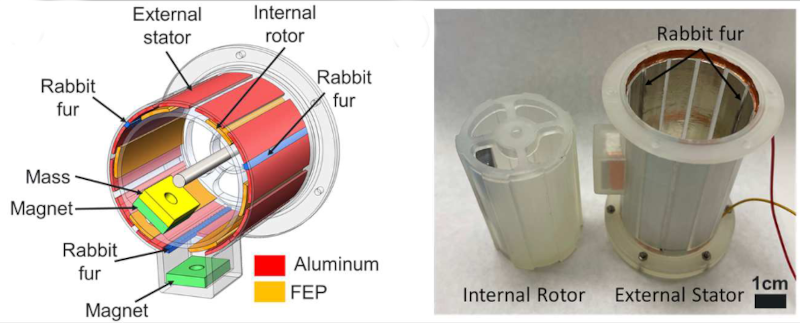Water is heavy, so if you think about it, a moving ocean wave has quite a bit of energy. Scientists have a new way to use triboelectric generators to harvest that power for oceangoing systems. (PDF) Triboelectric nanogenerators (TENGs) are nothing new, but this new approach allows for operation where the waves have lower amplitude and frequency, making traditional systems useless.
The new approach uses a rotor and a stator, along with some aluminum, magnets, and — no kidding — rabbit fur. The stator is 3D printed in resin. The idea is to mechanically accumulate and amplify small low-frequency waves into high-frequency motion suitable for triboelectric generation.
The paper has a lot of information about modeling both waves and how triboelectric generators work. Part of the construction will be familiar to people working with resin 3D printers: FEP film, which serves as the insulating part of the generator.
The paper discusses a demonstration of using the generator to power an acoustic transmitter. The generator charges a capacitor, and when there is sufficient charging, the system uses it to send data acoustically.
If you think using FEP film in a triboelectric generator is odd, try Scotch tape. In fact, we’ve seen it done more than once.

















There have been LOTS of attempts to harness ocean movement for electricity generation. It’s not an efficiency problem.
All the tidal energy capture systems ever built have been smashed apart by storms.
https://www.youtube.com/watch?v=nCrTsWtPVIY
A few have rusted to pieces before catching a big storm.
Don’t forget the one that burned down, fell over, then sank into the swamp. ;)
And they built another one, and that burned down, fell over, then sank into the swamp.
Currently two large scale. Really it’s more about economics than anything.
https://taraenergy.com/blog/tidal-energy-renewable-energy-source/
It is about the rabbit fur. They will get nowhere until they switch to cat fur.
That made me laugh out loud.
I recently posed questions about pipes down to the sea bed in the hope it would inspire thought about harnessing the pressure difference, which can be more than 400 times that at sea level, not a single comment, surely that pressure can be harnessed?
Not sure how to use that pressure difference (don’t know if it’s even possible) but one of Arthur C. Clarke’s short stories posited a system that used the *temperature* difference between way-down-there and hot surface water (shallow blackened pool exposed to the sun) to produce electricity. A temperature difference of around 90°C is possible depending on sun and location.
Essentially, solar power that uses a giant thermocouple instead of (expensive, fragile) photovoltaics.
Difficulties: it has to be big to be practical. Has to be at the (sunny) shore of a very deep lake or the ocean. And the ‘cold’ end ought to be below the thermocline where the temperature levels off to ~4°C….about a kilometer down.
I believe I responded.
I suggested you talk to your middle school earth science teacher to explain why it wouldn’t work.
They might have deleted the comment…bloody fascists! Was as ‘kind and respectful’ as I can manage.
I think you’re just trolling. No adult on hackaday can be so ignorant. A smart middle schooler could explain it to you.
Fark is that way —> They love ‘promised no math people’ there. Ban people for knowing math.
That’s why this one makes sense: it’s not a greenwashing campaign. It’s just a mechanism to catch a few joules for a remote buoy to squeeze out a momentary signal. At least if I’m reading right. That’s a good use.
Putting massive sheets of flotsam in the ocean to try and make “green” electricity for mass consumption out of waves just pisses me off.
In that case I can’t help but think a standard, simple, cheap solar panel with zero moving parts might be more suited to bobbing about in the ocean.
There’s always waves in the ocean. There isn’t always sun. So another solution than PV is good.
Depending on the ocean there may well be a lot more sun than waves
And there’s the self-winding clock mechanism, invented somewhere in the 18th century. No rabbits would be harmed, but also no money from patents would be made.
I’m sure this will generate a great deal of clean energy for the researchers’ curriculum vitae and funding records. The rest of it, not so much.
https://www.youtube.com/watch?v=nKysLQxjwUs
Rabbit fur, high voltage, and waves of water? Hay, what about rabbits on a hop-mill that’s like a treadmill with a hay feeder at the top. Hay in, pellets and energy out. Easily reproduced.
Zombie power.
They do work with no energy input!
We can make it true.
Vote Vermin Supreme!
Vote Pony party!
I developed a much better wave generator machine and a magnet motor that produces usable torque and RPM.
Anyone interested let me know. I’ve been trying to put them out but naturally claimed “impossible” …. So was going to the moon not too long ago.